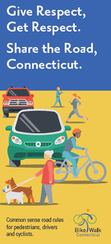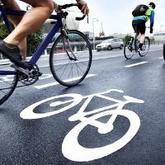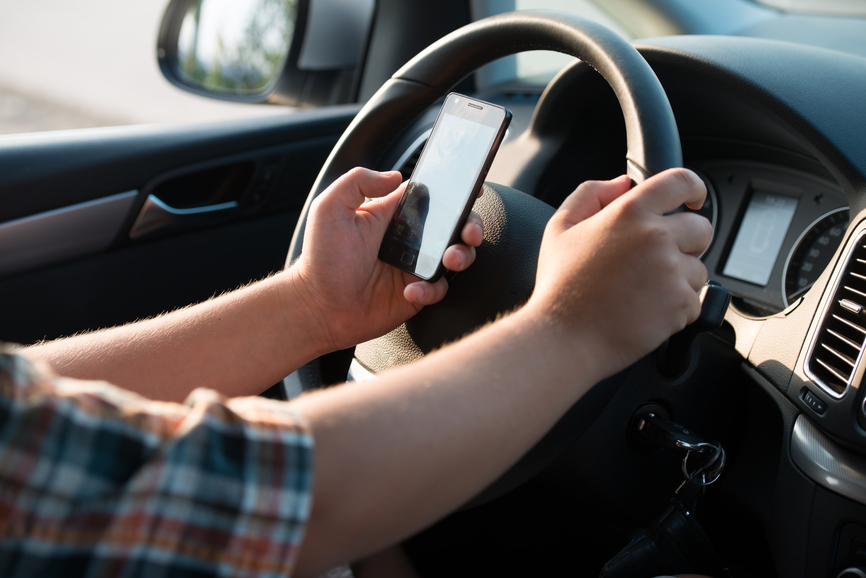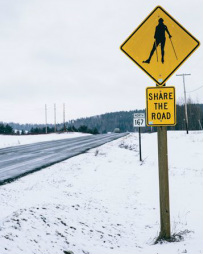 Attention Bike Walk CT members! This being a budget year and a short legislative session, we expected the legislature’s focus to be on the budget and transportation lockbox. So we’re thrilled that the Judiciary Committee has raised HB 5403, An Act Increasing Penalties For Failure To Yield To Pedestrians In Crosswalks And Failure To Exercise Due Care To Avoid Hitting A Pedestrian Or Cyclist. The bill would increase the fine from a maximum of $90 to a maximum of $500. The Judiciary Committee is holding a public hearing on HB 5403 and others on March 2 at 1 pm in Stamford at the Gen Re Auditorium of the UConn Stamford Campus. (1 University Place, Stamford, CT 06901). A massive showing of Bike Walk CT members would be quite impactful. If you’ve been hit or can otherwise testify to the need for safer behavior on the roads, please consider attending the hearing and testifying about your experience. We’ll send details shortly about message points to consider for your written testimony, which you may send by email if you can’t attend the hearing in person. Yes, the increased dollar amount still pales in comparison to the injury that drivers so often cause when they hit pedestrians and cyclists. Nor does HB 5403 address the little known but problematic 2007 amendment to Conn. Gen. Stat. §14-300(c) that changed the requirement for drivers to yield to pedestrians in or at a crosswalk to requiring them to yield only when pedestrians have already stepped off the curb or are in a crosswalk. The new rule doesn't seem to be getting much enforcement, but neither did the old rule. Nevertheless, HB 5403 and the March 2 hearing present a huge opportunity for Bike Walk CT members to let the legislature know just how much work remains to be done to make Connecticut a better, safer place for all the people who want to bike and walk. Safety concerns are the number one reason that keeps people (and their kids) from walking and biking as much as they’d like. And remember - respect on the roads goes both ways. See our Give Respect, Get Respect brochure on the rules for cyclists, pedestrians and drivers to share the road. Please follow them every time. Bike Walk Connecticut's mission is to change the culture of transportation through advocacy and education to make bicycling and walking safe, feasible, and attractive for a healthier, cleaner Connecticut.  Everybody should feel safe using Connecticut’s roads. Connecticut’s roads are traveled by walkers, runners, and cyclists who are welcome and expected to use the roads for transportation, fitness, and recreation. With common courtesy, common sense, and respect for the rules to share the road, Connecticut’s roads can be safer for everyone. Please do your part whether you’re driving, cycling, walking, or running. Bike Walk Connecticut, the statewide organization that works for active transportation and making Connecticut a better place to bike and walk, has released a new brochure to remind drivers, cyclists, and pedestrians on the rules for sharing the road. Our Give Respect, Get Respect: Share the Road, Connecticut brochure is available for download at http://www.bikewalkct.org/share-the-road. Think you know the rules? Let's see! Take our Share the Road IQ Quiz here, or on YouTube. Thanks to the New Britain Herald for helping to get the word out on CT's important new bike laws. Read the full story here: http://bit.ly/1M1dh1K
Bicyclists have more freedom to determine how to safely ride on Connecticut roads, and motorists have more room to pass them as a result of changes to Connecticut’s laws for cyclists, which took effect July 1. Public Act 15-41 was passed in May with broad bipartisan support and was signed June 1 by Gov. Dannel P. Malloy. The new law eliminates the rule requiring cyclists to always ride as far to the right edge of the road as possible, but also gives motorists permission to cross double-yellow lines when passing slower-moving cyclists. The law allows cyclists to determine how close to the curb to ride in certain circumstances, rather than always as close as possible. Bike Walk Connecticut specifically advocated for the new language, which is modeled on best practice in Colorado and endorsed by the League of American Bicyclists. The new law allows for the designation of two-way bicycle lanes, buffered bike lanes and cycle tracks. Cyclists are not required to ride as close to the right side of the road as possible in the following instances: ∎ Overtaking or passing another vehicle proceeding in the same direction; ∎ Preparing for a left turn at an intersection or into a private road or driveway; ∎ Avoiding fixed or moving objects, parked or moving vehicles, bicycles, pedestrians, animals, surface hazards or lanes that are too narrow for a bicycle and a motor vehicle to travel safely side-by-side; ∎ Approaching an intersection where right turns are permitted and there is a dedicated right turn lane, in which case a bicyclist may ride on the left hand side of the lane; ∎ Riding on a roadway designated for one-way traffic, when the bicyclist may ride as near to the left hand curb as is judged safe; ∎ Riding in designated bicycle lanes. For more information visit bikewalkct.org. For Immediate Release  July 1, 2015 (Hartford, CT) -- Important changes to Connecticut's laws for cyclists take effect July 1, 2015. The Bicycle Safety bill, Senate Bill 502 and now Public Act 15-41, was passed in May with broad bipartisan support. The Governor signed the bill into law on June 1. The new law eliminates the confusing--and often unsafe--rule requiring cyclists to ride as far to the right as practicable. Instead, the law now requires cyclists to ride as close to the right side of the road as is safe, as judged by the cyclist. Bike Walk Connecticut specifically advocated for that language, which is modeled on a best practice from Colorado as identified by the League of American Bicyclists. As of July 1, cyclists don't have to ride as close to the right side of the road when:
The new law also allows two-way bicycle lanes, buffered bike lanes, and cycle tracks to be designed in Connecticut and allows drivers to cross the double yellow line to pass slower-moving cyclists and other road users when it's safe to do so. Watch for more information from Bike Walk CT this summer about Sharing the Road. For more information, contact Bike Walk CT Exec. Dir. Kelly Kennedy at 860.578.5925. Susan Tuz, reporter for the Danbury-based News-Times, asks: Can bikes and cars coexist? Fatal accidents demonstrate need for increased awareness, separate lanes By Susan Tuz, Sun. June 28, 2015 The negligent homicide charge filed last week against a New Milford man in the 2014 death of a bicyclist highlighted the growing potential for collisions between motor vehicles and increasingly numerous two-wheelers. Although bicycle commuting in Greater Danbury is still uncommon, recreational use is on the rise, and a 2014 state law requires that the needs of cyclists — including, for example, the provision of designated bike lanes — be taken into account in planning for new transportation projects. Advocates for motorists and cyclists agree that both groups must better learn the rules of the road in order to avoid accidents like the one that killed Dwight Hipp, 57, while he was riding one morning last August on Route 109 — the fourth such fatality in the region since 2010. John Kimberley, 23, is scheduled to appear in court Monday in Bantam to face charges that could put him in jail up to six months. From 2008 to 2012, 11 other cyclists were left incapacitated after collisions with motor vehicles, according to a study for the Housatonic Valley Council of Elected Officials. Kelly Kennedy, executive director of Bike Walk CT, said the state “is approaching a tipping point.” “A Share the Road campaign is something Connecticut needs to work on,” Kennedy said. “Courtesy and awareness on the roadway goes both ways. Cyclists need to be predictable, and drivers have to be aware of cyclists.” While both groups need to be aware of each other, the state recognizes that a person on a bicycle is at a definite disadvantage in a standoff with a car or truck. A recent Vulnerable Road User law prohibits motorists from impeding cyclists when making a right turn, gives cyclists the right of way in intersections and requires drivers to maintain three feet of clearance when passing a bike. “Drivers have to get used to cyclists being on the roads,” said Tom O’Brien, president of the New Milford River Trails Association. “We all need to drive slower when in a car or truck and use more caution when there are pedestrians or cyclists on the road.” But cyclists, too, have their responsibilities. In Connecticut, the same traffic laws that apply to motorists apply to cyclists: Stop signs and traffic lights must be obeyed, hand signals must be used to indicate stops and turns, and cyclists generally must ride as close as possible to the right side of the roadway [*but see important note below], traveling in the same direction as motorists. Read the full story here * Bike Walk CT Note: The 2015 Bike Safety Bill (Public Act 2015-41, effective July 1, 2015) makes important changes to the old rule to ride "as far to the right as is practicable."
The new rule, effective July 1, 2015, is that "Any person operating a bicycle upon a roadway at less than the normal speed of traffic shall ride as close to the right side of the roadway as is safe, as judged by the bicyclist." Under the new law, there are six situations when bicyclists do not have to ride to the right of the road: (1) When overtaking or passing another vehicle proceeding in the same direction; (2) When preparing for a left turn at an intersection or into a private road or driveway; (3) When reasonably necessary to avoid conditions, including, but not limited to, fixed or moving objects, parked or moving vehicles, bicycles, pedestrians, animals, surface hazards or lanes that are too narrow for a bicycle and a motor vehicle to travel safely side by side within such lanes; (4) When approaching an intersection where right turns are permitted and there is a dedicated right turn lane, in which case a bicyclist may ride on the left-hand side of such dedicated lane, even if the bicyclist does not intend to turn right; (5) When riding on a roadway designated for one-way traffic, when the bicyclist may ride as near to the left-hand curb or edge of such roadway as judged safe by the bicyclist; or (6) When riding on parts of roadways set aside for the exclusive use of bicycles, including, but not limited to, counter-flow bicycle lanes, left-handed cycle tracks on one-way streets and two-way cycle tracks. by Tom Harkness
At this point, everyone knows the dangers of texting while driving. Distracted driving not only puts yourself at risk but also those around you, including your passengers, other drivers, pedestrians, and cyclists. Thankfully, authorities are cracking down on the issue and the proof of their efforts speak for themselves. Since enacting the ban on texting while driving, according to an article in Bloomberg, "traffic fatalities dropped 3% in states that allow police to pull over drivers for texting." They also note that States that focus the prohibition specifically on younger drivers cut traffic deaths among 15- to 21-year-olds by 11%." Impressive. However, even with the rising improvements in driving safety, this time of year it's especially important to give your children a review of safe-driving techniques. They might roll their eyes and say they've heard all this before. However, when they return to school, your kids who are of the legal driving age will likely be traveling in heavier traffic than they typically dealt with over the summer. They will also be surrounded by less-experienced drivers that might not take the same safety precautions. A review of defensive driving techniques and ways to keep themselves secure while behind the wheel can make all the difference. One easy way in particular that you can go over vehicle safety with them is by utilizing Verizon Wireless' "It's Up to Me" app. By texting DRIVING to 74579, motorists can take get the facts on distracted driving and even take a quiz to test their knowledge on safe driving tactics. By doing the quiz together, you'll be able to see which areas they might still be unsure of, or have questions about. They also need to be comfortable with the increase of pedestrian and biking traffic that are inevitable with the start of school. According to AAA, 13% of children nationwide either bike or walk to school regularly. They also report that "The afternoon hours are particularly dangerous—over the last decade, nearly one in four child pedestrian fatalities occurred between 3 and 7 p.m." Remind your kids about the importance of utilizing defensive driving techniques not only with other cars, but everyone they share the road with. At the very least, they should keep a minimum of three feet between their vehicle and a cyclist, and they should always be ready for the unexpected. Things can get hectic when school gets out in the afternoon, and it's just as easy for a pedestrian or cyclist to get distracted. To all those behind the wheel, remember that it's not just your life that you're putting at risk when you allow yourself to be distracted while driving. Always stay aware, because texting can wait. Town Councilor and chair of West Hartford's Public Safety Committee Harry Captain has proposed a resolution concerning the renewal and strengthening of the town's commitment to traffic, pedestrian and cyclist safety. The resolution addresses safety and right of way issues for pedestrians, cyclists and vehicles, and directs the town manager to reinvigorate safety efforts.
West Hartford Assistant Police Chief Bob McCue is on board with the effort. McCue is quoted as saying "There are a lot of things you have no control over, but accidents are preventable. The theme is always to get folks to realize they've got to share the road. No one has a God-given right to have a straight shot to their place of employment or home or anything, You've got to be respectful of everyone else." Amen to that! Click here to read the full West Hartford Life story by Abigail Albair. The story starts at page 54. Read the resolution here. We'll update this post when we have confirmation that it passed at the August 26 town council meeting. Is there news we can use from your town? Let us know--we're always looking!  Google's image today covers Mothers Day and National Bike to Work Week. Google's image today covers Mothers Day and National Bike to Work Week. HAMDEN — Traveling on Connecticut roadways require care and courtesy, whether operating a car or a bicycle. To generate a greater awareness for bicycles — in May/National Bicycle Safety Month, and at all times of the year — AAA Southern New England shares these tips for motorists and bicyclists alike. Motorists must:
The new free program means AAA members can request assistance if a disabled bicycle needs minor repairs or requires transportation to a nearby destination within one of these three counties. To request service, members call the 800-AAA-HELP (800-222-4357), the roadside assistance number on their AAA membership card. An AAA service vehicle will meet members on any generally traveled road within AAA Southern New England’s territory, any time of day, 365 days a year. After attempting minor repairs, if the AAA technician is unable to get the member back on the road, the member and bicycle will be transported free of charge within a defined radius. More information on bicycle safety tips, brochures, videos, and the roadside assistance program, visitwww.aaa.com/bikesafety. |
Bike Walk Connecticut
NEWS Send us your bike walk related news and time permitting, we'll do our best to post it.
Topics
All
|
Photo from Roebot


